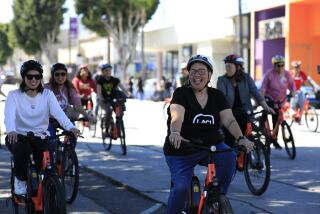First Times Ride: 2015 Harley-Davidson Street 750

The new Harley-Davidson Street 750 is among the company’s lightest and nimble motorcycles.
Harley-Davidson’s new Street 500s and 750s are the smallest and least expensive motorcycles the company has put onto the road in decades.
The result is a stripped-down, basic bike — Harley in its purest, barest, most accessible form.
Although they may not be popular with anyone who already owns a Hawg — too small, too quiet, too tame — they are likely to be attractive to anyone who’s ever wanted a Harley but been daunted by their size and cost.
The new bikes are part of the company’s push to attract new riders and to build a new generation of Harley owners who wouldn’t be caught dead on a chopper. As far back as 2009, said Matthew Levatich, Harley-Davidson Motor Co. president and chief operating officer, Harley began thinking about moving into smaller bikes.
“We started to think, ‘Can Harley do a smaller, liquid-cooled, nimble, urban motorcycle?’” he said. “We were looking at the global, urban, young adult marketplace, in places where the lighter, smaller-displacement motorcycles are a way of life — like certain Asian countries.”
The executive team was encouraged by the response they got when they canvassed dealers.
“Our dealer attitude was, ‘Finally! What took you guys so long?’” Levatich said. “They felt there had been a lot of people on the outside of Harley-Davidson, looking in, who weren’t being taken care of.”
The matte-black Street 750 sits low — less than 26 inches — and has a shorter wheelbase than other smaller Harleys, like the Sportster. The distances between the rider and the ground, the seat and the foot pegs, and the seat and the handlebars are all designed to make smaller riders feel comfortable and in command.
The liquid-cooled, fuel-injected Revolution X engine is new for Harley, too, and it’s impressive — peppy and powerful, with a claimed 44.3 foot-pounds of torque, and responsive up and down the power band. It doesn’t growl as gruffly as a big Harley, but it has plenty of pep and gets up to speed quickly.
Once at speed, it feels sturdier than its stature would suggest. At 60, 70 and 80 mph, it feels sold and stable on the freeway. The six-speed transmission is belt-driven, which cuts vibration and noise and makes for smooth acceleration and cruising.
It’s cheap, too. With an MSRP of $7,499 and fuel economy at a claimed 41 miles per gallon, the Street 750 will be cheaper to acquire and operate than anything in the Harley line since the company stopped offering Buell 500s. The Street 500 starts at $6,799.
But that price point creates limitations. The instrumentation is limited to how fast you’re going and how far you’ve gone — no fuel gauge, no tachometer, no clock, just the basics, with warning lights for low fuel or low oil pressure.
The fit and finish is in keeping with the bike’s cost. But so too are some of the major chassis elements. The suspension is not adjustable and brakes are just barely adequate. You can get going fast a lot faster than you can stop.
Levatich said Harley will build and ship as many as 10,000 of the Streets in 2014. The first models were 500s, and went to fill orders from the dealers for use in the riding academies. The rest — two-thirds of them 750s, one-third 500s — will be retail models ready to sell.
Is there concern that the quieter, lighter-weight, more civilized Streets will somehow offend the hard-core Harley customer?
Levatich notes that the company has introduced revolutionary changes in the past and weathered them.
“We introduced electronic fuel injection a few years ago, and now we have no carburetors on any of our motorcycles,” Levatich said. “Today, believe me, no one is asking me, ‘Can you make it so my bike doesn’t start when I want to ride it?’ Nobody is asking me that.”







